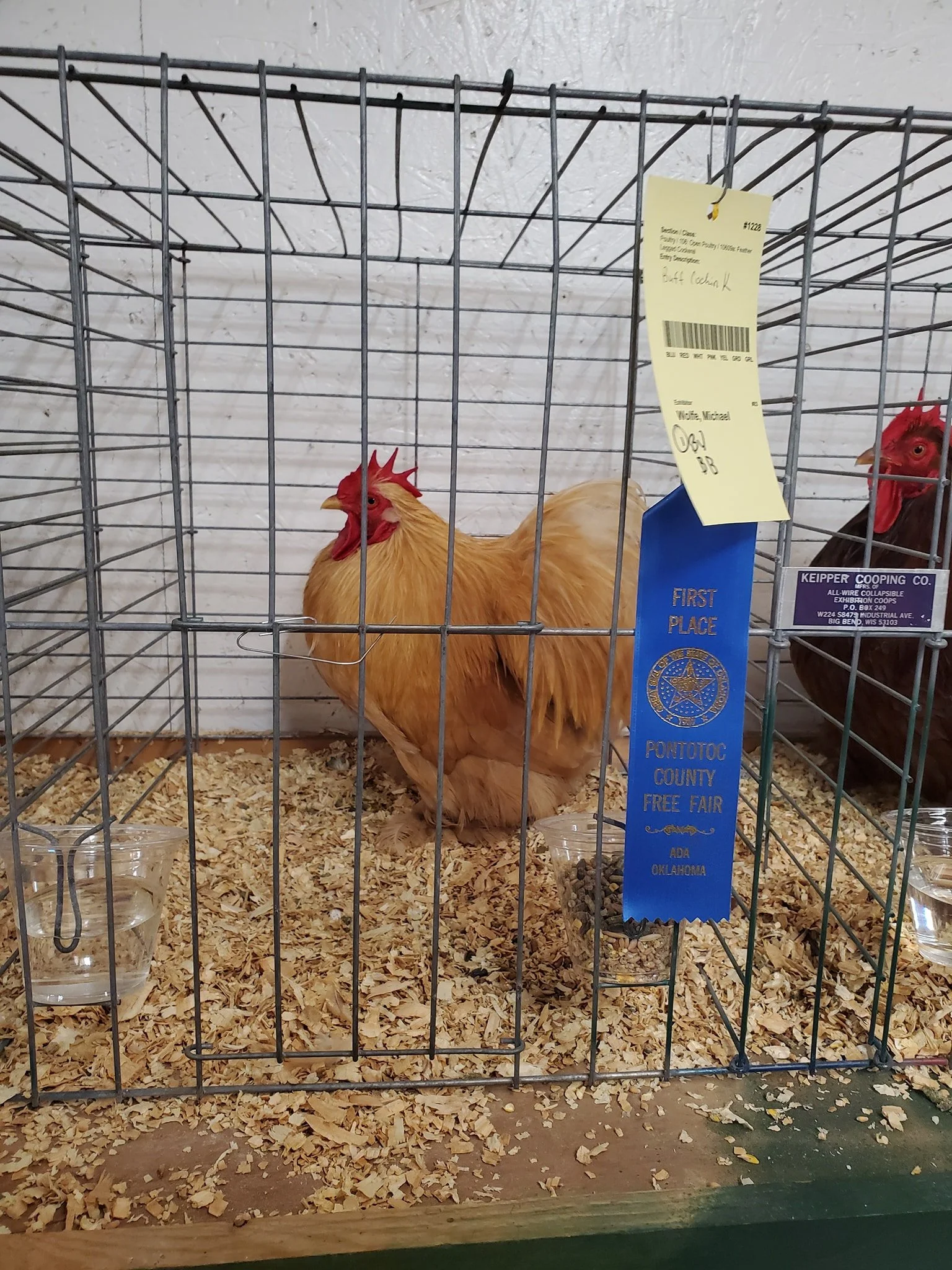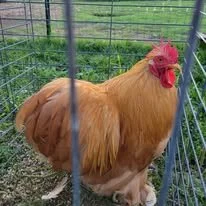 Image 1 of 2
Image 1 of 2

 Image 2 of 2
Image 2 of 2



Bantam Buff Cochin Chicks
Buff Cochin Bantams
Started in 2020 with a pair from Richard Andree and reinforced in 2023 when John Beauchamp sent additional birds to deepen consistency, our Buff line has a road-trip origin story we still smile about. After WRC Nationals in Minneapolis, we headed north to see Ted Massa, tucked a few goslings into the already crowded minivan, and then swung by Richard’s on the way back. We had a blast—we talked birds for about an hour, and although we’d planned to pick up Reds, we came home with both Buffs and Reds (yes, we somehow found space between rabbit carriers and goslings). Since then, with 14 years in poultry (and nearly six focused on Cochins), we’ve built on that start by selecting for the classic rounded Cochin outline, calm, people-oriented temperament, feather quality, and a rich, even buff that shows beautifully in the show coop. These birds are steady on the hand—great for first-time breeders who like a little bit of a challenge and youth exhibitors—and we offer started chicks at 3–4 weeks to give families a sturdier, easier start while feathering is well underway.
Quick facts (standard & variety)
Class: Feather-Legged Bantam; Variety: Buff — recognized by both APA & ABA.
Standard weights (ABA): Cock 30 oz, Hen 26 oz, Cockerel 26 oz, Pullet 24 oz.
Type details: Single comb; red face, wattles, and earlobes; heavy foot and shank feathering over yellow skin/soles; plumage rich, even buff from head to tail. (Buff can show sooty “smut,” light blue peppering, or a few black feathers—we select toward clean, uniform buff.)
Terminology note: We use “muffed” to mean heavily foot-feathered (APA/ABA term = “booted”).
Production & personality
Eggs: Small/tinted brown; typically ~150 eggs/year under good management (Cochins are a “fair” layer overall).
Broodiness: Excellent natural mothers; go broody readily.
Temperament: Exceptionally docile and easy to handle—great for showmanship and youth projects.
Care notes for new breeders & youth
Provide partial shade during bright months; buff plumage can sunburn/bleach, softening surface color. Shade cloth, trees, or roof overhangs help retain richness.
Keep birds clean and dry to protect muffed feet and preserve the buff surface; avoid muddy runs that stain feathers.
Cochins mature on the slower side; pullets commonly begin laying around 5–6 months.
Color clarity, chicks, and “surprises”
Buff is a color you manage, not just “have”: through the first juvenile molts, light blue peppering or the odd black feather can appear or fade; we breed away from it, but it’s part of working with buff lines.
Our matings have even produced Reds on occasion. We separate obvious Reds before shipping and will identify them for you; however, subtle smut may not be present on started chicks at 3–4 weeks and can molt in—or out—over time. If you’re chasing show-ring buff, we’ll guide you on which youngsters to grow on.
What you’ll see in our pen
Compact, rounded bodies with abundant fluff; rich, even buff that holds its glow with sensible shade; calm birds that pose naturally—everything you want in a competitive junior project bird. Our ongoing selection emphasizes correct weight, feather quality, carriage, uniform color, and easy handling for new exhibitors and breeders.
Buff Cochin Bantams
Started in 2020 with a pair from Richard Andree and reinforced in 2023 when John Beauchamp sent additional birds to deepen consistency, our Buff line has a road-trip origin story we still smile about. After WRC Nationals in Minneapolis, we headed north to see Ted Massa, tucked a few goslings into the already crowded minivan, and then swung by Richard’s on the way back. We had a blast—we talked birds for about an hour, and although we’d planned to pick up Reds, we came home with both Buffs and Reds (yes, we somehow found space between rabbit carriers and goslings). Since then, with 14 years in poultry (and nearly six focused on Cochins), we’ve built on that start by selecting for the classic rounded Cochin outline, calm, people-oriented temperament, feather quality, and a rich, even buff that shows beautifully in the show coop. These birds are steady on the hand—great for first-time breeders who like a little bit of a challenge and youth exhibitors—and we offer started chicks at 3–4 weeks to give families a sturdier, easier start while feathering is well underway.
Quick facts (standard & variety)
Class: Feather-Legged Bantam; Variety: Buff — recognized by both APA & ABA.
Standard weights (ABA): Cock 30 oz, Hen 26 oz, Cockerel 26 oz, Pullet 24 oz.
Type details: Single comb; red face, wattles, and earlobes; heavy foot and shank feathering over yellow skin/soles; plumage rich, even buff from head to tail. (Buff can show sooty “smut,” light blue peppering, or a few black feathers—we select toward clean, uniform buff.)
Terminology note: We use “muffed” to mean heavily foot-feathered (APA/ABA term = “booted”).
Production & personality
Eggs: Small/tinted brown; typically ~150 eggs/year under good management (Cochins are a “fair” layer overall).
Broodiness: Excellent natural mothers; go broody readily.
Temperament: Exceptionally docile and easy to handle—great for showmanship and youth projects.
Care notes for new breeders & youth
Provide partial shade during bright months; buff plumage can sunburn/bleach, softening surface color. Shade cloth, trees, or roof overhangs help retain richness.
Keep birds clean and dry to protect muffed feet and preserve the buff surface; avoid muddy runs that stain feathers.
Cochins mature on the slower side; pullets commonly begin laying around 5–6 months.
Color clarity, chicks, and “surprises”
Buff is a color you manage, not just “have”: through the first juvenile molts, light blue peppering or the odd black feather can appear or fade; we breed away from it, but it’s part of working with buff lines.
Our matings have even produced Reds on occasion. We separate obvious Reds before shipping and will identify them for you; however, subtle smut may not be present on started chicks at 3–4 weeks and can molt in—or out—over time. If you’re chasing show-ring buff, we’ll guide you on which youngsters to grow on.
What you’ll see in our pen
Compact, rounded bodies with abundant fluff; rich, even buff that holds its glow with sensible shade; calm birds that pose naturally—everything you want in a competitive junior project bird. Our ongoing selection emphasizes correct weight, feather quality, carriage, uniform color, and easy handling for new exhibitors and breeders.